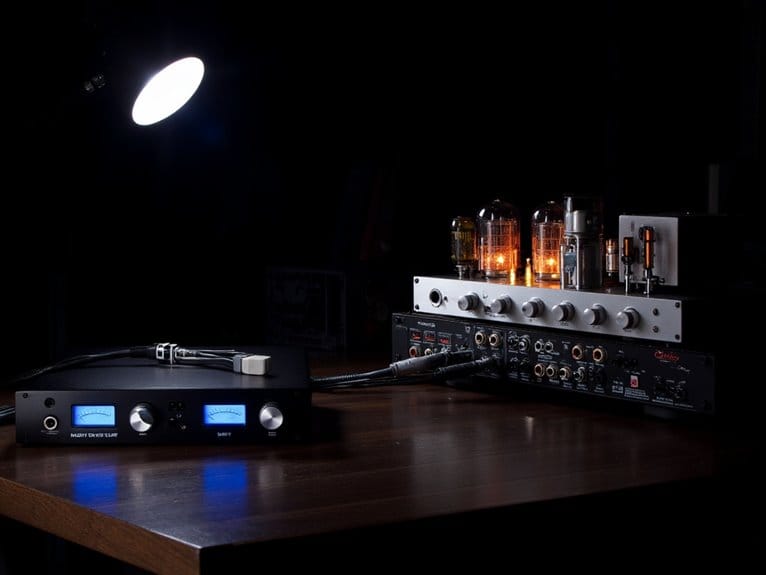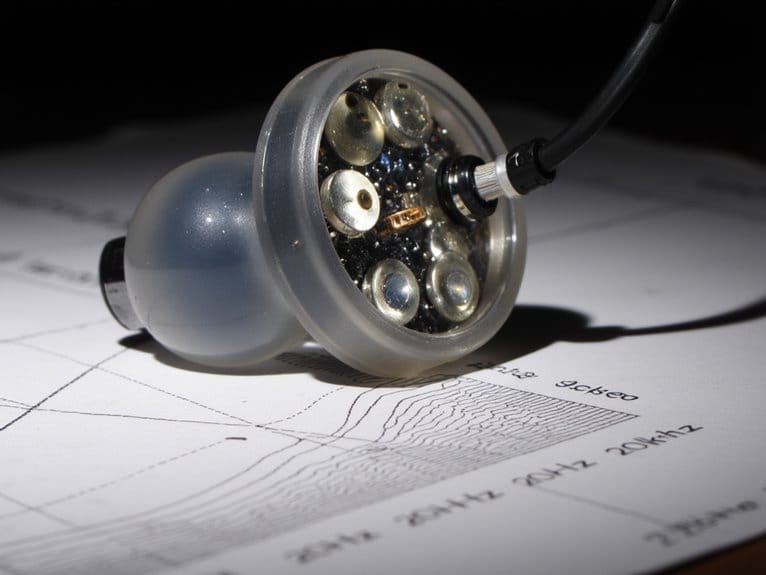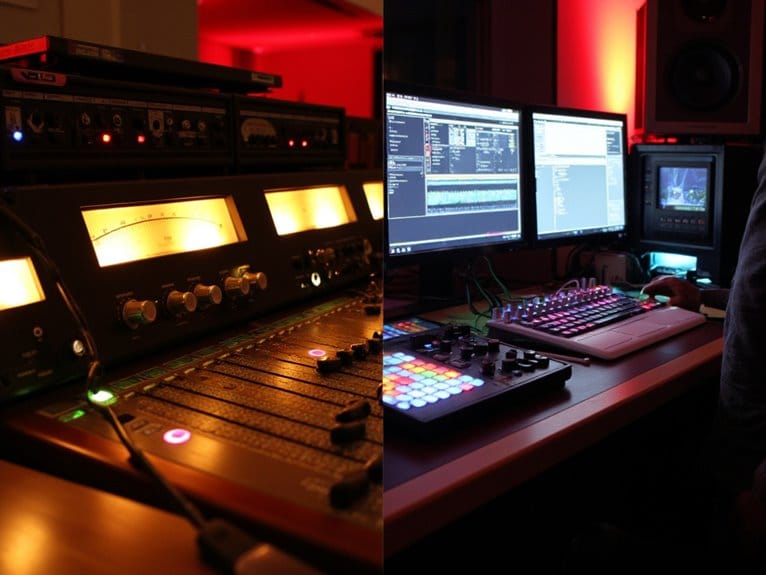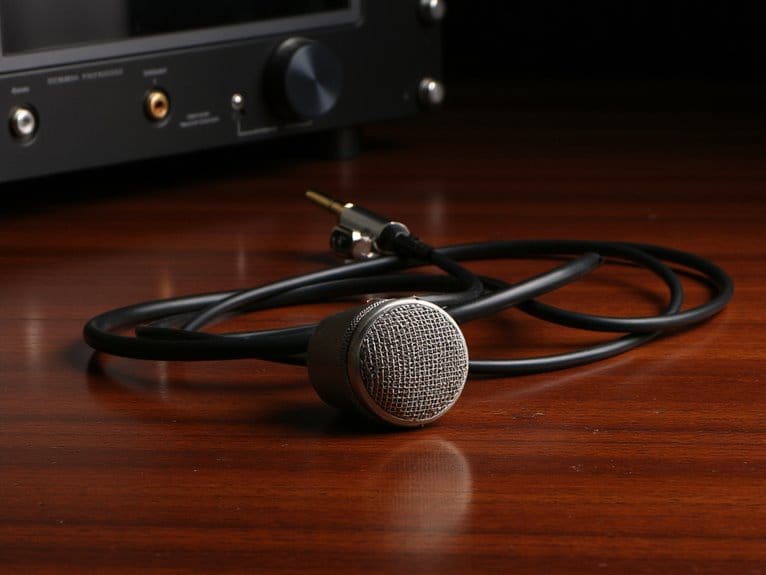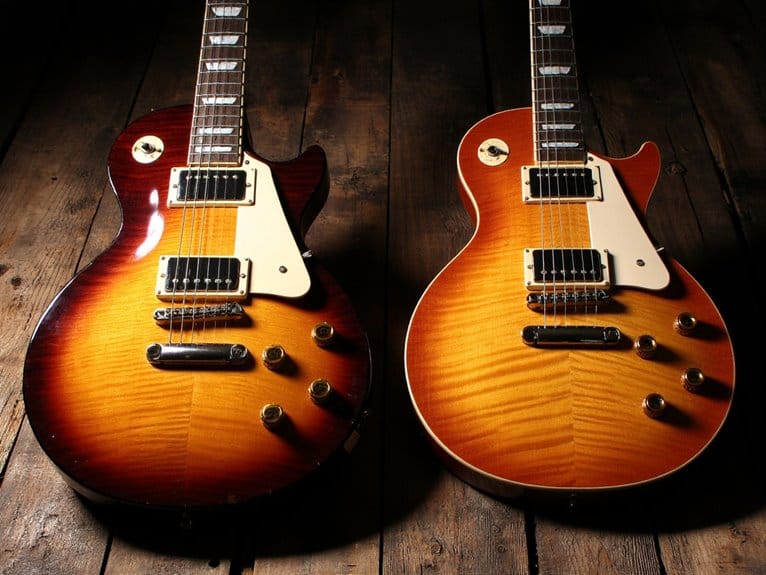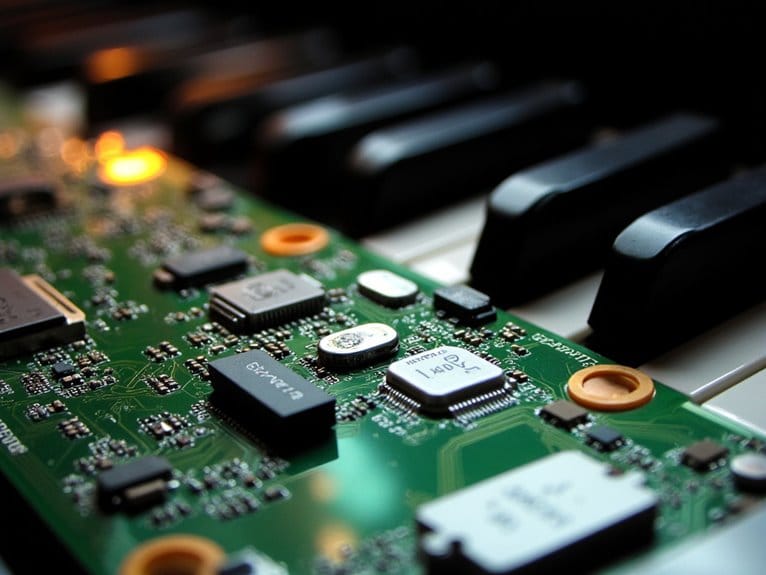Audio Interface Preamps: Built-In Vs External
You’ll find that built-in preamps in modern audio interfaces like the Focusrite Scarlett series offer impressive 62dB gain and convenience for home studios, while external preamps deliver superior sound character, higher gain levels, and upgrade flexibility that built-in options can’t match. Built-in preamps work well for solo recording and mobile setups, but external units provide the sonic refinement and tonal enhancement that professional applications demand. The choice ultimately depends on your budget, recording goals, and whether you prioritize convenience or plan to expand your studio capabilities over time.
We are supported by our audience. When you purchase through links on our site, we may earn an affiliate commission, at no extra cost for you. Learn more.
Notable Insights
- Built-in preamps offer convenience and space-saving benefits, making them ideal for home studios and portable recording setups.
- External preamps provide superior sound quality, higher gain levels, and greater tonal flexibility for professional applications.
- Audio interfaces with built-in preamps cost $200-$600, while external preamps require additional investment plus cables and rack space.
- Built-in preamps limit upgrade options, requiring full interface replacement, whereas external units allow gradual system improvements.
- Professional interfaces achieve -130 dB noise floors with 24-bit/192kHz resolution, suitable for most recording needs regardless of preamp type.
Understanding the Core Functions of Preamps and Audio Interfaces
When you’re diving into the world of audio recording, I’ll admit that the relationship between preamps and audio interfaces can seem confusing at first, but understanding their core functions is essential for building any effective recording setup.
Think of preamps as specialized amplifiers that boost your microphone’s weak signals to usable levels, dramatically improving signal quality by reducing noise and standardizing output levels. Quality preamps with ultralow-noise characteristics are crucial for recording clarity and minimizing interference during the recording process.
Audio interfaces, on the other hand, serve as digital translators that convert your analog signals into computer-readable data through ADC conversion, while also handling the reverse process for playback. Professional audio interfaces typically support 24-bit/192kHz resolution for studio-grade recording quality across various applications.
Most modern interfaces include built-in preamps for convenience, though they also offer various connectivity options for external units, giving you flexibility to customize your recording chain based on your specific needs and budget. Professional setups often utilize multiple channels to capture full band recordings or complex arrangements where several microphones need to operate simultaneously.
Preamps are available in different forms, from standalone units to built-in options in mixers and amplifiers, with tube-based designs offering unique sonic characteristics compared to their solid-state counterparts.
Built-In Preamp Performance and Limitations
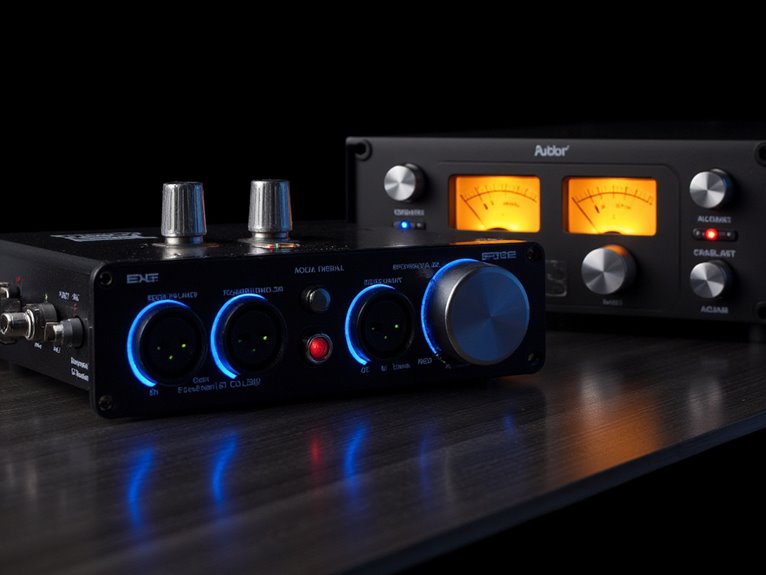
While many audio engineers debate whether external preamps are worth the investment, I’ve found that built-in preamps have reached impressive quality levels that can genuinely surprise you, especially when you consider models like the Focusrite Scarlett series with its 62dB gain range or the Audient iD4 MkII‘s console-grade circuitry.
However, despite this impressive built in sound quality, you’ll encounter certain limitations that affect preamp quality decisions:
- Limited customization options compared to external units with multiple tone-shaping controls
- Upgrade constraints requiring complete interface replacement rather than component-level improvements
- Sound character restrictions that don’t match specialized external preamps’ unique sonic signatures
- Dynamic range limitations in high-end recording scenarios where premium external units excel
While these constraints exist, I’ve discovered that modern built-in preamps handle most home studio applications exceptionally well. Many users prefer external preamps because they add warmth and depth that internal preamps often lack. The low noise floor achieved by quality interfaces like the Focusrite Scarlett 2i2 demonstrates how built-in preamps can deliver professional-grade transparency without additional hardware investment. Quality built-in preamps with zero-latency monitoring also eliminate the timing issues that can plague live recording and streaming scenarios. The Focusrite Scarlett 18i20 takes this further with its 122 dB dynamic range and Auto Gain feature, delivering professional results that rival external preamp setups.
External Preamp Advantages and Sound Enhancement
Though built-in preamps have certainly earned their place in modern recording setups, I’ve consistently found that external preamps deliver a level of sonic refinement and creative flexibility that can transform your recordings from merely good to genuinely exceptional.
When conducting preamps comparison tests, you’ll notice external units typically feature superior components, dedicated power supplies, and more complex circuit designs that translate into cleaner amplification with enhanced dynamic range.
Their unique tonal characteristics, whether tube warmth or transistor clarity, provide distinct sound processing capabilities that built-in preamps simply can’t match. You’ll appreciate the flexibility of swapping different external units to achieve specific sonic goals, plus their professional-grade shielding reduces electromagnetic interference for noticeably cleaner recordings.
External preamps can be used in conjunction with audio interface systems, allowing you to bypass built-in preamp functionality when you need that extra level of sonic enhancement. Many professional outboard preamps also offer up to 80dB of clean gain, making them particularly valuable when working with low-output microphones that demand substantial amplification.
Cost Analysis and Budget Planning
How much should you realistically budget for preamps in your recording setup? The answer depends on your specific needs, workflow demands, and long-term goals, though I’ve found that effective budget strategies often prioritize functionality over prestige when starting out.
Effective preamp budgeting prioritizes practical functionality over brand prestige, especially when building your initial recording setup.
Cost comparisons reveal significant differences between built-in and external options:
- Audio interfaces with built-in preamps typically range from $200-$600, offering multiple functions within one affordable package.
- External preamps can cost as much as entire interface bundles but provide superior components and isolated power supplies.
- Hidden costs include additional cables, rack space, and power requirements for external units.
- Long-term value favors external preamps through better resale potential and independent upgradeability.
Consider your current production requirements carefully, as quality external preamps often justify their higher initial investment through improved recording results. External preamps offer enhanced sound coloration control for achieving your desired sonic character. Remember that preamps directly impact the final tonality of your recordings since any characteristics introduced at this stage will affect the entire signal chain. Professional interfaces under $1000 now commonly feature 24-bit recording capabilities that deliver studio-grade results regardless of whether you choose built-in or external preamp solutions. Many quality interfaces feature plug-and-play setups that simplify installation and reduce technical barriers for newcomers to audio recording.
Choosing the Right Setup for Your Recording Needs
With your budget considerations mapped out, you’ll need to match preamp specifications to your actual recording scenarios, studio space limitations, and production workflow requirements. Portability concerns become critical when you’re frequently moving between locations, making built-in preamps ideal for mobile setups despite their limited customization options. Conversely, external preamps suit fixed studios where setup complexity isn’t a daily concern, offering superior dynamic range and tone shaping capabilities.
Many interfaces now feature ADAT expansion capabilities that bridge the gap between built-in convenience and external flexibility, allowing you to start with integrated preamps and add external units later without replacing your entire setup. When evaluating preamp quality, remember that noise floor measurements reveal the electrical noise generated during operation, with professional interfaces typically achieving -130 dB or better performance levels.
Built-in preamps often include helpful visual indicators like Gain Halos that show signal levels at a glance, making it easier to monitor your recording levels without constantly watching software meters. Low-output dynamic microphones like the Shure SM7B require interfaces capable of delivering at least 60dB of clean gain to achieve optimal performance without external boosters.
| Recording Scenario | Built-In Preamps | External Preamps |
|---|---|---|
| Home Studio | Convenient, space-saving | Better sound quality |
| Mobile Recording | Highly portable | Bulky, power requirements |
| Professional Studio | Limited features | Full customization |
| Solo Artists | Sufficient quality | Overkill for simple needs |
| Multi-track Projects | Basic functionality | Enhanced signal routing |
Consider your upgrade path—external units provide independent improvement opportunities, while built-in preamps require complete interface replacement.
Frequently Asked Questions
Can I Use Multiple External Preamps Simultaneously With One Audio Interface?
You can definitely use multiple external preamps simultaneously, though signal routing and preamp compatibility become critical factors in your setup.
I’ve found that interfaces with dedicated line inputs handle analog connections best, while ADAT optical ports let you expand digitally with compatible preamp units.
You’ll need proper cable management and gain staging to prevent issues, but it’s totally achievable with careful planning.
Do External Preamps Require Phantom Power or Provide It Themselves?
External preamps typically provide their own phantom power rather than requiring it from your interface, which honestly makes preamp compatibility much simpler than you’d expect.
Most quality external preamps include dedicated 48V supplies for condenser mics, so you’ll actually want to disable phantom power on your interface channels that connect to these preamps via XLR to prevent potential damage.
Will Adding External Preamps Introduce Additional Latency During Recording Sessions?
You won’t experience additional preamp latency when adding external preamps to your recording setup, since they’re analog devices that don’t require digital conversion.
I’ve found that recording efficiency actually improves because latency originates from your interface’s converters and DAW processing, not the preamps themselves.
Your signal path remains purely analog until it hits the interface’s A/D converter, maintaining the same latency characteristics you’d have without external preamps.
Are Tube Preamps Better Than Solid-State for Specific Microphone Types?
Tube characteristics aren’t inherently better than solid-state for specific mics, but rather complement certain microphone compatibility scenarios.
You’ll find tube preamps add warmth to bright condenser mics or solid-state dynamics, while solid-state preamps balance already-warm tube microphones effectively.
I’ve learned through experience that matching complementary tonalities, rather than doubling similar characteristics, typically yields better results than assuming one preamp type is universally superior.
Can I Bypass Built-In Preamps When Using External Ones?
You can’t completely bypass built-in preamps on most interfaces, though bypassing preamps depends entirely on your specific interface configurations.
Line inputs typically skip the variable gain stage but still pass through fixed-gain circuits.
I’ve found that setting your interface’s gain to minimum effectively reduces the built-in preamp’s influence when using external units, though true bypass requires specialized interfaces designed specifically for external preamp integration.
On a final note
You’ll find that choosing between built-in and external preamps ultimately depends on your specific recording goals, budget constraints, and quality expectations. If you’re starting out, your audio interface’s built-in preamps will serve you well for most applications. However, when you’re ready to elevate your sound quality and add character to your recordings, investing in dedicated external preamps becomes a worthwhile upgrade that’ll enhance your overall production capabilities markedly.

